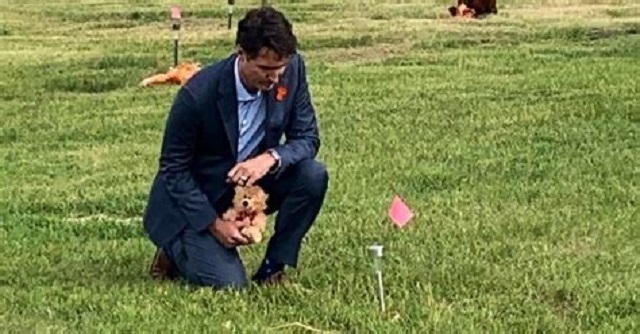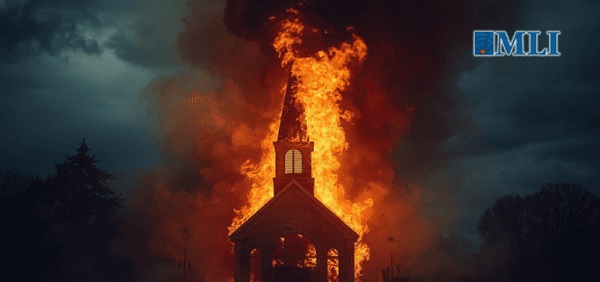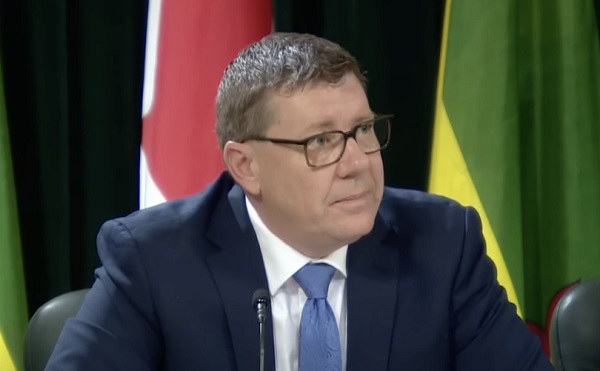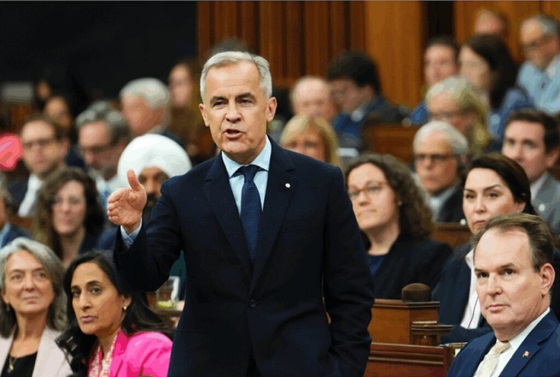Frontier Centre for Public Policy
Is the Price of Reconciliation that we Must Pretend to Believe a Lie?

From the Frontier Centre for Public Policy
Even the Kamloops band is backing away from its most extreme claim, that ‘bodies were found’
The price we are being told that we must pay to achieve “reconciliation” is becoming clear. We must pretend to believe a lie.
The lie is that 215, and then thousands, of indigenous students of residential schools were “disappeared” while at the schools — that they died under sinister circumstances while under the care of the priests, nuns and teachers running the schools, and were buried in secrecy.
To top it off, it is claimed that fellow students — “as young as six” — were forced by these evil priests to dig the graves. The fact that there is not one scintilla of good evidence to support this deeply anti-Catholic blood libel is not supposed to deter us from accepting it as fact. We are being told that we must pretend to believe this lie if we want to achieve “reconciliation”.
If there was any doubt that the Assembly of First Nations (AFN) was insisting that Canadians must pretend to believe the false claim, it was dispelled when they angrily rejected the funding cap that the federal government had placed on its ill-considered promise to provide a total of $320 million to indigenous communities that chose to go on their own “missing children/unmarked graves” search.
The chiefs showed who was boss, and the federal government meekly submitted, and cancelled the funding cap.
The government coffers were left wide open, and indigenous communities expanded existing searches for “missing children.” In reality these children were never missing. As Tom Flanagan explains in Grave Error (above), they were “forgotten children” who had been properly buried in marked graves that were subsequently left untended and forgotten by their families.
Be that as it may, as a result of AFN activism, and government and media incompetence, the Kamloops claim morphed into an officially sanctioned lie.
But where is the truth in all of this?
Most of us knew, even when this claim was first made in 2021, that these grisly tales of sinister deaths and secret burials could not possibly be true.
There is simply no historical record of any such thing occurring.
There are no records of parents frantically looking for children who suddenly went missing from residential schools, no police reports of missing children. Nothing.
In fact the extensive records we do have say exactly the opposite — namely that the deaths of children who sadly died of the diseases of the day at residential schools were all properly recorded, and that almost all of the deceased children were buried by their parents on their home reserves.
The small minority who were buried in special school cemeteries, (because the transportation of the bodies back to remote reserves was impractical,) all received Christian burials. Their places of burial were made known to their parents. The fact is that record keeping of indigenous children at residential schools was far superior to record keeping of the children on reserves, where far greater numbers died of exactly the same diseases.
But for reasons best left to future historians to ponder the Trudeau government and its CBC media ally immediately accepted the crackpot Kamloops claim as true. CBC and other gullible media went into overdrive pumping out misinformation in support of the baseless claim, while the Trudeau government ordered all flags on federal buildings across Canada lowered, where they remained for six months!
Trudeau’s indigenous affairs minister, Marc Miller — perhaps the worst Indian Affairs minister in the history of this country — recklessly promised $320 million to indigenous communities that wanted to make similar claims. And, of course, others did almost immediately.
Down the road, Chief Willie Sellars, of the Williams Lake indigenous community, outdid the rhetoric of his colleague, Chief Casimir. According to Sellars, priests had not only killed countless indigenous children, but had thrown their bodies into “rivers, streams and lakes” as well as the usual old standards of throwing bodies into school furnaces and incinerators. Other communities wanting in on the money jumped onto the bandwagon with increasingly fantastical tales.
The result of this Trudeau government recklessness — aided by a gullible media that asked no questions — was predictable. These false stories became etched in stone as the truth within the indigenous community. A victim mentality that was already deeply imbedded became pathological, as indigenous communities became convinced — on evidence that was entirely false — that they were victims of a genocide committed by their neighbours.
The chiefs also silenced the many thoughtful members within their communities who knew that these stories of murderous priests were not true. As investigative reporter, Terry Glavin, explains, even among the Tk’emlups community there were always sensible voices who did not believe those claims:
“From the outset, even among Tk’emlúps people there was a great deal of skepticism and disbelief in stories about nuns waking children in the middle of the night to bury their murdered classmates under the light of the moon”
But instead of heeding those sensible indigenous voices, and even as it became increasingly clear to Canadians that these stories were just tall tales, there was so much money in it that the chiefs doubled down. They insisted that Canadians must pretend to believe that the claims were true.
That would be their price for “reconciliation”.
As noted above, the weak Liberal government gave into this blackmail by removing the funding cap on searches it had tried to impose. But other important institutions cravenly played along with what was now an officially sanctioned lie as well.
Jon Kay explains in his recent Quillette essay how the Law Society of British Columbia is now insisting that anyone who wants to be a lawyer in that province must pretend to believe the “evil priest” line of stories.
Other law schools and law societies across Canada are doing this as well. They are so focused on what they perceive as the holy grail of “reconciliation” that they are prepared to sacrifice a pursuit of truth as their goal, and force their own students — our future lawyers and judges — to do the same.
Our public schools — to bring about “reconciliation — are indoctrinating our children with lessons about the “215 Kamloops graves” and other misinformation, such as the “Charlie Wenjack” story.
Children are taught that Wenjack was abused by Catholic priests and nuns in his residential school, and ran away as a result.
In fact, as author and historian Robert MacBain explains in his important book, “The Lonely Death Of An Ojibway Boy” Charlie Wenjack lived at a Protestant hostel run by a kindly indigenous family, attended school by the day in Kenora, and probably never saw a residential school, or met a priest or nun, in his life.
But, in the interests of “reconciliation” our children are being misinformed by their teachers.
And when a teacher does dare to tell the truth, as when B.C. teacher, Jim McMurtry told his students that the children who died in residential schools died of the diseases of the day — and were not tortured to death, as was being reported — he was frogmarched from his classroom, and summarily fired.
Or Frances Widdowson, who was fired from her tenured university position largely for daring to dispute what was becoming an increasingly extreme residential school narrative.
All of this obvious unfairness, is happening in the name of “reconciliation.” The senior lawyers who oversee the Law Society, and the educators who select our children’s school curricula are doing a great disservice to this country. As are our MPs who foolishly labelled Canada as genocidal, based on the same false Kamloops claim.
As are our senior indigenous leaders, who know by know that the murderous, secret-burying priest story has always been just a silly ghost story that children tell to scare one another. Yet they insist that Canadians must pretend to believe it, or they will withhold the “reconciliation” that they wield like a sledge hammer over our heads.
It should have occurred to everyone by now that if the price of “reconciliation” is pretending to believe a lie, the price is far too high. That kind of “reconciliation” is worth nothing.
In actual fact, what this country and its indigenous population needs is not “reconciliation” at all. Too many indigenous people are stuck at the bottom of the socioeconomic ladder. What they need is not “reconciliation” but integration into the economy, and the opportunity to participate in it. As for the opportunists who exploit a false claim to benefit themselves, they deserve only our contempt.
What nobody needs is a country where citizens must lie to each other in order to stay together.
And now, to add insult to injury, MP Leah Gazan wants to make it a law that we must all lie to each other by criminalizing what she calls “residential school denialism”. She specifically singles out the Kamloops claim as something Canadians must accept as true. As she sees it any Canadian who refuses to do so, or who dares to suggest that the positives, as well as the negatives of residential schooling should be recognized, should be made a criminal. Dostoevsky famously asked if there will come a time “when intelligent people will be banned from thinking, so as not to offend the imbeciles”. Has that time arrived?
Brian Giesbrecht, retired judge, is a Senior Fellow at the Frontier Centre for Public Policy.
Frontier Centre for Public Policy
Canada Lets Child-Porn Offenders Off Easy While Targeting Bible Believers

From the Fr0ntier Centre for Public Policy
By Lee Harding
Judges struck down one-year minimum prison sentences for child pornography possession. Meanwhile, the chair of the Parliamentary Human Rights Committee publicly stated that religious scriptures condemning homosexuality are “hateful.” Lee Harding says the 1982 Charter has led to an inversion of Canadian values.
Light sentences for child-porn possession collide with federal signals that biblical texts could be prosecuted as hate
Was Canada’s 1982 Charter meant to condemn the Bible as hate literature or to weaken sentencing for child pornography? Like it or not, that is the direction post-Charter Canada is moving.
For Halloween, the black-robed justices at the Supreme Court of Canada ruled that a one-year mandatory sentence for accessing or possessing child sexual abuse materials amounted to “cruel and unusual punishment.” The judgment upheld a similar ruling from the Quebec Court of Appeal.
A narrow 5-4 majority leaned on a hypothetical. If an 18-year-old received a sexually explicit image from a 17-year-old girlfriend, that image would technically be child porn. If prosecuted, the recipient could face a one-year minimum sentence. On that basis, the judges rejected the entire minimum sentence law.
But the real case before them was far more disturbing. Two Quebec men possessed images and videos that were clearly the result of abuse. One had 317 unique images of child porn, with 90 per cent showing girls aged three to six years old forced into penetration and sodomy by adults or other minors. The other had 531 images and 274 videos of girls aged five to 10 engaged in sexual acts, including anal and vaginal penetration and, in some cases, multiple children.
The sentences were light. The first offender received 90 days of intermittent imprisonment, served concurrently, plus 24 months of probation. The second received nine months of imprisonment and the same probation period. How is this acceptable?
The judgment did not emerge without warning. Daniel A. Lang, a Liberal campaign chair appointed to the Senate by Lester B. Pearson, saw this coming more than 40 years ago. On April 23, 1981, he expressed concerns that the new Constitution could be used to erode basic decency laws. He pointed to the U.S. experience and predicted that Canada could face a wave of cases challenging laws on “obscenity, pornography and freedom of speech,” leading to the “negation of federal or provincial legislation.”
His warning has come true. If Parliament wants to restore mandatory minimum sentences, it can do so by passing a new law that removes the obscure scenario judges used to strike them down. Section 33, the notwithstanding clause, gives elected officials the power to override court rulings for up to five years at a time.
This reflects Canada’s own system. In the British tradition Canada inherited, Parliament—not the courts—is the ultimate authority. British common law developed over centuries through conventions and precedents shaped by elected lawmakers. Section 33 protects that balance by ensuring Parliament can still act when judges disagree.
There is a democratic check as well. If a government uses Section 33 and voters believe it made the wrong call, they can remove that government at the next election. A new government can then follow the judges’ views or let the old law expire after five years. That accountability is precisely why Section 33 strengthens democracy rather than weakening it.
Yet today, Ottawa is working to limit that safeguard. In September, the Carney Liberals asked the Supreme Court to rule on new limits to how legislatures can use Section 33. Five premiers wrote to Carney to oppose the move. Former Newfoundland and Labrador premier Brian Peckford, the last living signatory to the agreement that produced the 1982 Constitution Act, has also condemned the attempt as wrongful.
The judges will likely approve the new limits. Why would they refuse a chance to narrow the one tool elected governments have to get around their rulings? For decades, the Supreme Court has made a habit of striking down laws, telling Parliament it is wrong and forcing political change.
And while minimum sentences for child-porn offenders fall, the Carney cabinet is focused on something else entirely: prosecuting Bible believers for alleged hate.
The quiet part was said out loud by Montreal lawyer Marc Miller, former minister of immigration and citizenship and chair of the Parliamentary Human Rights Committee. On Oct. 30, he told the committee, “In Leviticus, Deuteronomy, Romans, there’s other passages, there’s clear hatred towards, for example, homosexuals.”
The former minister added, “There should perhaps be discretion for prosecutors to press charges … [T]here are clearly passages in religious texts that are clearly hateful.”
That is the former minister’s view. Instead of Bible thumpers, we now have Charter thumpers who use their “sacred” document to justify whatever interpretation suits their cause and wield it against their ideological opponents. When wokeness hardens into dogma, disagreement becomes heresy. And we know what happens to heretics.
A country that lets child-porn offenders off easy while it hunts down Bible believers for fines and possible prison has lost its way. Most Canadians would reject this trade-off, but their rulers do not, whether in cabinet or on the judges’ bench. A dark shadow is settling over the country.
Lee Harding is a research fellow for the Frontier Centre for Public Policy
Business
Ottawa Pretends To Pivot But Keeps Spending Like Trudeau

From the Frontier Centre for Public Policy
New script, same budget playbook. Nothing in the Carney budget breaks from the Trudeau years
Prime Minister Mark Carney’s first budget talks reform but delivers the same failed spending habits that defined the Trudeau years.
While speaking in the language of productivity, infrastructure and capital formation, the diction of grown-up economics, it still follows the same spending path that has driven federal budgets for years. The message sounds new, but the behaviour is unchanged.
Time will tell, to be fair, but it feels like more rhetoric, and we have seen this rhetoric lead to nothing before.
The government insists it has found a new path, one where public investment leads private growth. That sounds bold. However, it is more a rebranding than a reform. It is a shift in vocabulary, not in discipline. The government’s assumptions demand trust, not proof, and the budget offers little of the latter.
Former prime ministers Jean Chrétien and Paul Martin did not flirt with restraint; they executed it. Their budget cuts were deep, restored credibility, and revived Canada’s fiscal health when it was most needed. Ottawa shrank so the country could grow. Budget 2025 tries to invoke their spirit but not their actions. The contrast shows how far this budget falls short of real reform.
Former prime minister Stephen Harper, by contrast, treated balanced budgets as policy and principle. Even during the global financial crisis, his government used stimulus as a bridge, not a way of life. It cut taxes widely and consistently, limited public service growth and placed the long-term burden on restraint rather than rhetoric. Carney’s budget nods toward Harper’s focus on productivity and capital assets, yet it rejects the tax relief and spending controls that made his budgets coherent.
Then there is Justin Trudeau, the high tide of redistribution, vacuous identity politics and deficit-as-virtue posturing. Ottawa expanded into an ideological planner for everything, including housing, climate, childcare, inclusion portfolios and every new identity category.
The federal government’s latest budget is the first hint of retreat from that style. The identity program fireworks are dimmer, though they have not disappeared. The social policy boosterism is quieter. Perhaps fiscal gravity has begun to whisper in the prime minister’s ear.
However, one cannot confuse tone for transformation.
Spending still rises at a pace the government cannot justify. Deficits have grown. The new fiscal anchor, which measures only day-to-day spending and omits capital projects and interest costs, allows Ottawa to present a balanced budget while still adding to the deficit. The budget relies on the hopeful assumption that Ottawa’s capital spending will attract private investment on a scale economists politely describe as ambitious.
The housing file illustrates the contradiction. New funding for the construction of purpose-built rentals and a larger federal role in modular and subsidized housing builds announced in the budget is presented as a productivity measure, yet continues the Trudeau-era instinct to centralize housing policy rather than fix the levers that matter. Permitting delays, zoning rigidity, municipal approvals and labour shortages continue to slow actual construction. These barriers fall under provincial and municipal control, meaning federal spending cannot accelerate construction unless those governments change their rules. The example shows how federal spending avoids the real obstacles to growth.
Defence spending tells the same story. Budget 2025 offers incremental funding and some procurement gestures, but it avoids the core problem: Canada’s procurement system is broken. Delays stretch across decades. Projects become obsolete before contracts are signed. The system cannot buy a ship, an aircraft or an armoured vehicle without cost overruns and missed timelines. The money flows, but the forces do not get the equipment they need.
Most importantly, the structural problems remain untouched: no regulatory reform for major projects, no tax-competitiveness agenda and no strategy for shrinking a federal bureaucracy that has grown faster than the economy it governs. Ottawa presides over a low-productivity country but insists that a new accounting framework will solve what decades of overregulation and policy clutter have created. The budget avoids the hard decisions that make countries more productive.
From an Alberta vantage, the pivot is welcome but inadequate. The economy that pays for Confederation receives more rhetorical respect, yet the same regulatory thicket that blocks pipelines and mines remains intact. The government praises capital formation but still undermines the key sectors that generate it.
Budget 2025 tries to walk like Chrétien and talk like Harper while spending like Trudeau. That is not a transformation. It is a costume change. The country needed a budget that prioritized growth rooted in tangible assets and real productivity. What it got instead is a rhetorical turn without the courage to cut, streamline or reform.
Canada does not require a new budgeting vocabulary. It requires a government willing to govern in the country’s best interests.
Marco Navarro-Genie is vice-president of research at the Frontier Centre for Public Policy and co-author with Barry Cooper of Canada’s COVID: The Story of a Pandemic Moral Panic (2023).
-

 Alberta2 days ago
Alberta2 days agoAlberta’s huge oil sands reserves dwarf U.S. shale
-

 Indigenous2 days ago
Indigenous2 days agoResidential school burials controversy continues to fuel wave of church arsons, new data suggests
-

 Health2 days ago
Health2 days agoSaskatchewan woman approved for euthanasia urged to seek medical help in Canada rather than US
-

 International2 days ago
International2 days agoFBI didn’t think it had cause to raid Trump but DOJ did it anyway
-

 Daily Caller2 days ago
Daily Caller2 days agoParis Climate Deal Now Decade-Old Disaster
-

 Business2 days ago
Business2 days agoOttawa Pretends To Pivot But Keeps Spending Like Trudeau
-

 International1 day ago
International1 day agoBondi Beach Shows Why Self-Defense Is a Vital Right
-

 Energy2 days ago
Energy2 days agoLiberals Twisted Themselves Into Pretzels Over Their Own Pipeline MOU






